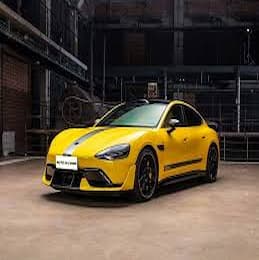Since at least the 1930s, concept cars of some form have existed. Most are promptly forgotten as soon as a new group appears, but many are remembered by the public for years. Car concepts could almost entirely remain behind closed doors, or they could be used to promote the brand at a global auto show, or it could be something else entirely.
Concept Cars, The 1940 Aston Martin Atom
Originally equipped with a 2.0-liter overhead-cam engine, the Atom was a compact and strikingly designed sedan. However, in 1944, it was replaced by a pushrod engine with a slightly bigger capacity.
It must have impressed David Brown (1904-1993), who drove it just before he decided to purchase the business, but a production version was never made.
Concept Cars, The 1955 Chrysler Falcon
The Falcon, a fast two-seat roadster with a 4.5-liter Chrysler Hemi V8 engine, was principally designed by Virgil Exner (1909–1973) and constructed by Ghia.
It may have been a rival for both the first-generation Ford Thunderbird and the original Chevrolet Corvette, but Chrysler chose not to proceed with its release. It was unveiled two years after the first Chevrolet Corvette.
The 1968 Alfa Romeo Carabo
When Marcello Gandini created the scissor doors and low wedge shape for the mid-engined Carabo, he must have been staring straight ahead into the future. The world may not have been prepared for anything like this in the 1960s, but Alfa Romeo prevented it from progressing past the concept stage.
The Carabo, however, is very similar to another vehicle that Gandini created. In contrast to the previous concept, the Lamborghini Countach went on sale in 1974.
READ ALSO: Xiaomi SU7 Ultra Vehicle: Redefining Speed
The 1970 Mazda RX-500
The RX-500 initially appeared to have been created for similar purposes as the Alfa Romeo Carabo. It had a mid-mounted engine (in this instance a twin-rotor), butterfly swing doors, gullwing engine covers, and a wedge shape—albeit not nearly as severe as the Carabo’s.
All of this shouted “supercar!” but the RX-500 was actually designed to highlight Mazda’s safety studies. It included a row of lights at the back, among other things, to let oncoming vehicles know if the vehicle was closing down, accelerating, or maintaining speed.
Concept Cars, Nissan 126X
The 126X, another wedge-shaped idea from 1970 (a lot of that kind of stuff was going on at the time), shared the Mazda RX-500’s changeable rear lights.
It had a slightly less supercar-like form than the Alfa Carabo or Mazda, but it was still somewhat strange. Nissan outperformed the other manufacturers in one area: the roof, windshield, and front body panels were all part of a canopy that opened from the front to provide access to the cabin.
Concept Cars, The 1976 Alfa Romeo New York Taxi
Despite being only four meters (157 inches) long, Italdesign’s solution to a challenge set by the New York Museum of Modern Art was able to accommodate five people and had room underneath the seats for folding wheelchairs. Sliding doors on both sides added to the practicality, which was rather unique for 1976.
You don’t now link Alfa Romeo with New York taxis because the project was abandoned after the car was constructed. Shame, because it’s a fascinating idea.
Concept Cars, 1978, Lancia Sibilo
The Megagamma and the Sibilio are only related since they both wore Lancia badges and attended the 1978 Turin Motor Show. They were as dissimilar from one another as chalk and China, otherwise.
In essence, the Bertone-designed Sibilo was an even longer and more bizarre-looking Stratos. A 2.4-liter Ferrari V6 engine powered both the idea and the final vehicle.
The 1986 Audi Sport Quattr RS 002
The RS 002 was never meant to be merely a theoretical idea. This mid-engined coupe was one of several vehicles constructed for the Group S international motorsport regulations, which were set to replace Group B in 1987. It used the same mechanics as the Quattro rally cars.
Group S was dropped in favor of the more production-based Group A after a string of catastrophic crashes. Before the car participated in a single race, the project was canceled because the RS 002 could not have been produced in sufficient quantities to qualify.
The 1992 Renault Reinastella
The Reinastella, a purely fictional vehicle that was reportedly part of the company’s lineup in the 2328 model year, was on display at Disneyland Paris. It was named after a real Renault that was temporarily manufactured about 1930.
Since it’s hard to choose the right tense in this situation, we’ll assume we’re talking from the middle of the 24th century and say that the Reinastella could fly up to 186 mph and fly 15 cm (6 in) over the road in town and 150 meters (492 ft) above it in the country. A prototype appears to have absorbed the remains of its two occupants when it crashed during desert testing. Renault employed a redesigned construction that was incompatible with animals for production models.
Concept Cars, 1999, Bugatti 18/3 Chiron
The 18/3 Chiron was first produced when Volkswagen first acquired Bugatti. A 6.3-liter, 555-bhp engine with 18 cylinders grouped in three banks—thus the 18/3 part of the car’s name—powered the three designs that were created around the same time.
The remainder alludes to Louis Chiron (1899–1979), a Monegasque driver who competed in a number of vehicle brands but is arguably best known for his exploits in Bugattis. Bugatti’s hypercar, which debuted in 2016, was given the Chiron name.
Concept Cars, 2006 Saab Aero X
Saab claims that the company’s background in aircraft design served as some inspiration for the Aero X. This was partially demonstrated by the need to raise the cockpit canopy in order to allow passengers to enter and exit, which may be troublesome if you were unlucky enough to land rubber side up.
It was claimed that a bioethanol-fueled twin-turbo engine could generate 400 horsepower, and the style elements suggested a future design language. Unfortunately, this was not very successful, and Saab was discontinued less than ten years after the Aero X was introduced.
2010 Citroen Metropolis
The Metropolis, an extremely large sedan that was especially popular in China, was as wide as a Maybach and longer as an Audi A8L. Power was provided by a 2.0-liter V6 engine and an electric motor as part of a gasoline-electric hybrid drivetrain. According to reports, this has the same amount of muscle as a 4.0-liter V8 that isn’t hybrid, but it emits a fifth as much CO2.
In 2020, the comparable DS 9 made its debut in China, while the Metropolis was never launched on the market.
2012, Chevrolet Code 130R
A tiny, rear-wheel-drive Chevrolet with a 1.4-liter turbocharged gasoline engine that could generate about 150 horsepower was proposed as the Code 130R.
There was a lot of support for a production version, and it was well received. One of the main reasons this never happened was because GM would have needed to create a new platform on which to build it.



